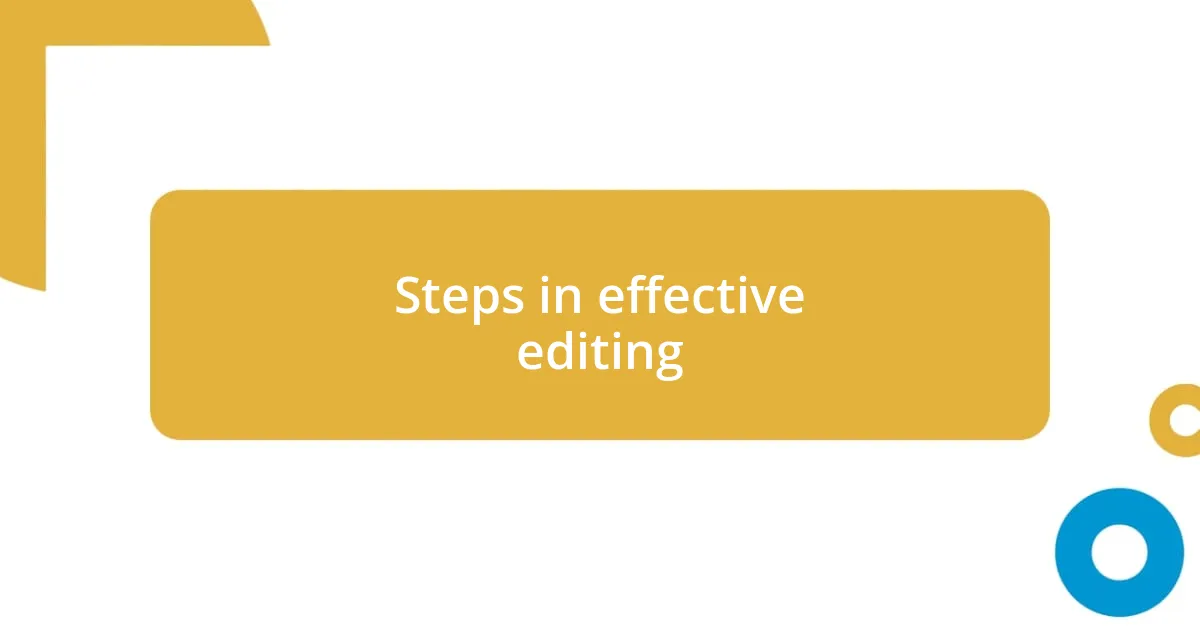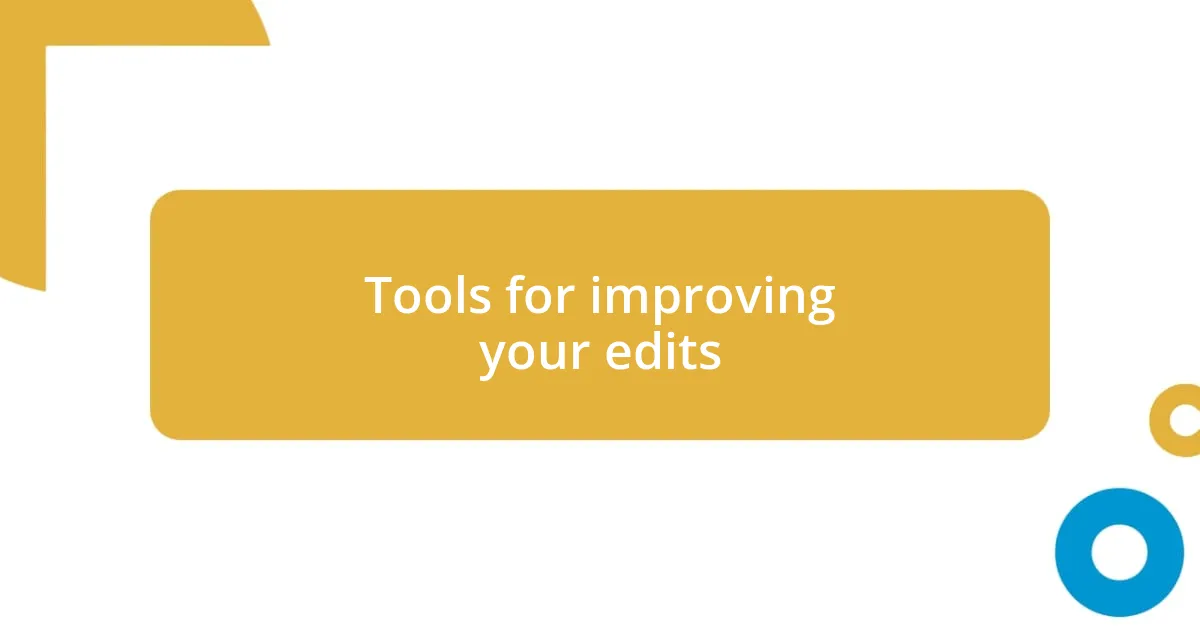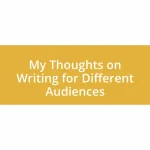Key takeaways:
- Editing is essential for refining thoughts, improving clarity, and enhancing connection with the audience.
- Effective editing steps include reading aloud, seeking feedback, and taking breaks for fresh insights.
- Avoid common mistakes such as neglecting grammar, overwriting, and inconsistent tone to maintain coherence.
- Utilize tools like grammar checkers and voice recording apps to improve the editing process and catch overlooked errors.

Understanding the editing process
Editing is an art form that transforms a rough draft into a polished piece. I remember the first time I revisited my writing after letting it sit for a while; the mistakes practically jumped off the page. Do you ever find yourself noticing things you completely overlooked in your initial draft?
In my experience, the editing process requires a delicate balance of critical thinking and creativity. It’s not just about correcting grammar or punctuation. I often ask myself, “Does this word choice convey what I truly mean?” This reflection can be both challenging and rewarding as I dig deeper into my thoughts and intentions.
Moreover, every edit brings a wave of mixed emotions—excitement for the potential of the piece and frustration when I struggle with finding the right phrasing. There’s something liberating about trimming excess content to let the main message shine through. Have you felt that rush when everything finally clicks into place?

Importance of editing in writing
Editing is crucial because it provides an opportunity to refine our thoughts and clarity. When I revisit a piece of writing, I often discover that a simple word change can improve the whole paragraph’s flow. It’s that thrilling moment of realization—I’ve unearthed a better way to express my ideas. Having that clarity not only makes for a more engaging read but also conveys confidence in my message.
- It sharpens the focus of the content, highlighting key points effectively.
- It helps identify inconsistencies or contradictions that may confuse readers.
- It allows for a more deliberate choice of words, boosting the overall quality and voice.
- It serves as a final layer of creativity, where ideas are fully fleshed out and polished.
Every edit enhances connection with the audience, ensuring what I say resonates with others. Each refining step feels less like a chore and more like an adventure—exploring new dimensions of the text, aligning my thoughts, and making the writing truly mine.

Steps in effective editing
One important step in effective editing is reading the text out loud. I often do this to catch awkward phrasing and run-on sentences that my eyes might miss. It creates a different rhythm, making the writing feel more alive, helping me identify where the flow falters. Have you tried this practice? It’s surprisingly effective.
Another stage I emphasize is getting feedback from others. While I may have a clear vision of my piece, outside perspectives can shine a light on areas I might not even consider. I remember sharing a draft with a friend, and their insights opened up new angles I hadn’t thought about. Their fresh take led me to improve not just that piece, but my overall approach to writing.
Finally, I always leave my work and come back to it later. This step might seem simple, but it brings clarity. When I revisit the piece with fresh eyes, I’m often surprised by how my understanding has evolved. It encourages me to make bolder choices or eliminate fluff, enhancing the overall impact of my writing. This process of distance is something I’ve come to cherish in my editing routine.
| Editing Step | Description |
|---|---|
| Read Aloud | Helps catch awkward phrasing and improves text flow. |
| Seek Feedback | Provides valuable outside perspectives to enhance clarity and depth. |
| Take a Break | Allows for fresh insights upon returning, leading to bolder editing choices. |

Common editing mistakes to avoid
One common editing mistake I’ve encountered is neglecting grammar and punctuation. It’s easy to gloss over these details when I’m deep into the creative flow. But let me tell you, I once submitted a piece riddled with commas misused, and the feedback was an eye-opener. Proper grammar isn’t just about rules; it shapes how readers perceive my writing. Have you experienced that embarrassing moment when someone points out a typo you never saw?
Another error I see often is the tendency to overwrite. I’ve been guilty of adding layers of adjectives and adverbs that clutter the message rather than enhancing it. When I reflect on past drafts, I realize that simpler phrasing often strikes a more powerful chord with my audience. For instance, I once wrote a paragraph that felt heavy with extra words, but after trimming it down, the impact was immediate. Sometimes, less truly is more.
Lastly, failing to maintain a consistent tone can be a major pitfall. I remember writing a blog post that jumped from formal to casual language mid-paragraph. It felt jarring, and readers noticed. I’ve learned to keep my audience in mind throughout the editing process, ensuring that the tone I select aligns with the message I wish to convey. It’s a subtle yet crucial detail that makes the whole writing feel cohesive.

Tools for improving your edits
When it comes to tools that enhance my editing process, I can’t stress enough the value of digital grammar checkers like Grammarly or ProWritingAid. These programs catch mistakes that often slip past my eyes, making them my go-to when I need a final polish. I remember rolling my eyes at the idea of automated editing tools, but once I tried them, I found they not only improved my grammar but also boosted my confidence to submit pieces I’d previously doubted.
Another indispensable tool in my arsenal is the Hemingway Editor. I love how it highlights complex sentences and suggests simpler alternatives. It’s not just about clarity for me; it’s about the rhythm and flow of the piece. There were times when I struggled with overly complicated expressions that I thought were clever. Using Hemingway, I discovered the beauty of brevity, learning that straightforward language often resonates more powerfully with my audience. Have you tried simplifying your phrasing? You might be pleasantly surprised at the impact it creates.
Lastly, I’ve recently delved into voice recording apps for feedback. Hearing my writing read back to me helps me spot repetitive phrases or unclear sections that I didn’t notice while reading. There was one moment while using this tool that truly stood out; I recorded a piece only to find myself cringing at how clunky it sounded. That realization led me to rework several sections. It’s a reminder of how important it is to listen to our own words; sometimes, they speak louder when voiced.

Seeking feedback during editing
One of the best practices I’ve adopted is seeking feedback from trusted peers during the editing phase. Recently, I shared an article with a fellow writer who pointed out a structural flaw I hadn’t even noticed. Their fresh perspective allowed me to see the piece through a different lens, reminding me how valuable an outside opinion can be in refining my work. Have you ever had someone catch an issue you completely missed?
I also like to gather feedback from diverse sources. In one instance, I circulated a draft among friends with varying backgrounds—some were writers, while others were enthusiasts in different fields. The responses ranged from stylistic critiques to content suggestions that I had never considered. This diversity not only enriched the piece but also opened my eyes to how different audiences perceive my writing. It made me wonder: shouldn’t we always aim to connect with wide-ranging readers?
Lastly, I make it a point to engage with feedback wholeheartedly, rather than defensively. There was a time when I felt a sense of dread opening up to critique, worried that it might deflate my artistic vision. But I learned that constructive criticism isn’t a personal attack; it’s a tool for growth. After one feedback session, I felt invigorated rather than defeated, inspired to polish my work into something even stronger. Isn’t that an exciting realization?

Finalizing your edited work
Finalizing your edited work is where the magic really happens. After going through various drafts and making countless tweaks, I remember the feeling of reaching that moment of clarity when I just know it’s ready for submission. Sometimes, I even print it out to read it with fresh eyes. Have you ever tried that? The tactile sensation of paper just feels different, doesn’t it?
I also find it valuable to take a short break after editing before giving it one last read-through. This technique allows me to approach my work with renewed perspective. I vividly recall a time when I stepped away for just an afternoon, only to discover glaring typos and awkward phrases that had eluded me before. It truly emphasizes how crucial it is not only to edit but also to step back and reflect.
Finally, I have a personal ritual of celebrating the completion of my editing process. Often, I treat myself to my favorite coffee or a short walk. This little act of recognition allows me to acknowledge my hard work and is a reminder to embrace the journey of writing, imperfections and all. Don’t you think that celebrating our progress adds to the joy of the creative process?














